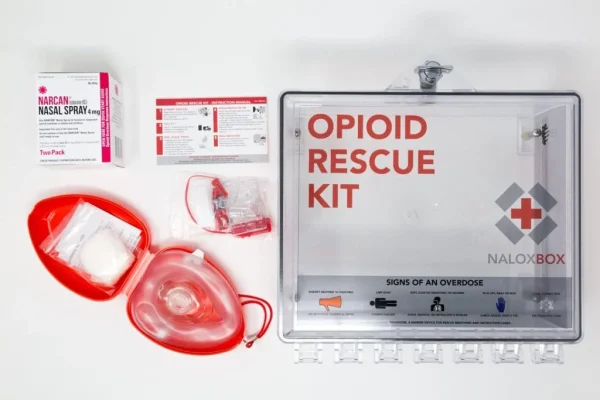As the local Washington, D.C., government continues to try and reduce record-high opioid overdose death rates, Francesca Hales (CAS ’26) is among a group of Georgetown University students aspiring toward making their own impact.
The Georgetown Homelessness Outreach, Meals and Education Program (HOME), a Georgetown Center for Social Justice (CSJ) outreach organization that does direct service and advocacy work for homeless people, is one of the clubs that is working to increase awareness about drug use and combat the ongoing opioid crisis. Serving as a research and advocacy coordinator at HOME, Hales is part of an effort to educate and train students to deal with overdose scenarios.
Hales said the current circumstances necessitate increasing awareness about the District’s drug problem.
“Especially as an individual living in D.C., basic understanding of harm reduction and overdose prevention is very important,” Hales told The Hoya.
The District reported 518 opioid-related deaths in 2023, making it the city with the third highest opioid mortality rate in the country, according to a March 20 report from the D.C. Office of the Chief Medical Examiner. The 2023 number represents a 12% increase from the number of deaths in 2022.
The new statistics on opioid overdose death rates follow a public emergency declaration from D.C. Mayor Muriel Bowser in November 2023 over the opioid crisis.
“We have too many people dying in our city related to fentanyl overdoses most specifically,” Bowser said at a Nov. 13 news conference.
Only 10% of people with a substance use disorder seek treatment, and this percentage is even higher among the African American population, signaling an inequity in access and trust in treatment facilities.
Kush Modi (CAS ’25), a HOME street outreach coordinator, said the organization is planning to increase the number of on-campus training and education sessions to spread awareness about the District’s worsening drug problem to the student body amid the developing crisis in Washington, D.C.
“We want to get as many students trained as possible because of the opioid crisis among unhoused people in D.C.,” he told The Hoya. “Hopefully we’ll never have to use [the training], but it’s important to at least know about the crisis.”
Georgetown Students’ Approach
In response to the crisis, Georgetown students have been mobilizing to increase awareness on campus. Multiple clubs are partnering with the D.C. non-profit Honoring Individual Power and Strength (HIPS) to host training sessions to teach students how to administer naloxone (Narcan), a nasal opioid overdose treatment.
Fentanyl was the cause of 98% of opioid-related fatal overdoses in the District in 2023. A trace amount of fentanyl can be fatal, according to the Centers for Disease Control and Prevention.
Overdose deaths continued to rise in 2023 and 2024, but the D.C. Council and Mayor Bowser recently allowed the public health emergency declaration to expire.
HOME conducts Narcan training sessions at least once a semester.
Hales said that she is hoping to have them become a larger part of HOME’s mission.
“We’re trying to have it be mandatory for everyone in the program and have training sessions a few times a semester,” Hales said.
Eliza Zaroff (CAS ’25), an attendee of a HOME Narcan training session in Fall 2023, said that the training sessions allow students to be more confident in dealing with unexpected crises.
“We’re in this sort of bubble at Georgetown,” Zaroff told The Hoya. “We don’t think it’s ever going to happen here, but I guess that’s the point. It can.”
Modi said the training sessions provide a greater level of security on campus.
“We always want more training sessions, and a lot of our volunteers have expressed a similar opinion,” Modi said. “If more people are trained, the chances of people dying from overdosing are much lower.”
Hales said Georgetown students understand the severity of the opioid crisis, even though they are less exposed to it than advocates at HIPS.
“Even though college students use drugs differently, there are still drugs here, and there can still be harms that we have to prepare for,” Hales said.
In addition to HOME and Hoya Drug Overdose Prevention and Education (HoyaDOPE), other clubs such as H*yas for Choice and Homeless Outreach Programs and Education (HOPE) have hosted training and education sessions to prepare students to administer Narcan. These student organizations have used training as a way to change mindsets about drug use and make them more prepared for an opioid overdose incident.
Professor Regina LaBelle, the director of the Addiction and Public Policy Initiative at the O’Neill Institute for National and Global Health Law at the Georgetown Law Center, said students’ response to the crisis has been quick and effective, especially in terms of providing access to Narcan.
“I’ve been impressed by student engagement on this issue,” Labelle wrote. “HoyaDOPE, a medical student group, plays an important role in getting naloxone to people at risk of overdose.”
Johnny Bailey, HIPS community outreach director, said the drug problem in D.C. started spiraling out of control when fentanyl became widely distributed in 2019.
“It’s always been an issue, but around 2019 or 2020 the supply chain got broken, and poison like fentanyl started getting mixed in with the dope to extend the supply,” Bailey told The Hoya. “Overdose isn’t even the right word anymore. These people are being poisoned. The drug world has become unsafe in a way that it was not before.”
In 2023, there were 43 opioid overdose deaths per month in D.C. compared to 17 opioid overdoses per month in 2018.
Hales said looking forward, she wants to make the training sessions more accessible to everyone on campus, and the university could set up optional training sessions during schoolwide events such as New Student Orientation to help clubs expand their reach.
“Clubs can hold Narcan training sessions, but we’re not going to get the same reach as if it were sponsored by the university,” Hales said.
Georgetown’s Involvement with Neighborhood Organizations
Since beginning as an education service for sex workers in D.C. in 1993, HIPS has expanded its aid to incorporate drug users and their communities. Bailey visits Georgetown’s campus a few times a semester to talk to students about opioid use and administering Narcan.
Bailey said he speaks at Georgetown and neighboring schools frequently because he wants to include younger voices.
“The question is how can we better bring in the youth?” Bailey said. “Nonprofits have a problem with reaching youth altogether. D.C. is terrible with it.”
Bailey said youth involvement helps raise awareness about drug use because students are less exposed to the crisis.
HIPS has partnered with HOME to host training sessions on the main campus during the fall semester where students were invited to practice administering emergency doses of Narcan.

Hales said HOME members have greatly benefitted from working with HIPS and plans to continue doing so in the future.
“Everyone in the program has done training with Johnny,” Hales said. “I’m really glad that the people in our organization have these basic skills.”
Hales said basic skills include identifying overdose, administering Narcan and knowing when to call authorities.
Bailey said it is urgent to save lives, while also making incremental progress toward safer drug practices, so the safest change to drug policy is legalization.
“In a perfect world, we can make drugs safer and have them regulated, but you know that’s not going to happen so we’re just trying to chip away at some of the other things that people are suffering from,” Bailey said.
Hales said Bailey’s presentations on harm reduction have been meaningful and compelling because they focus on preventing deaths.
“He talked about safer supply at the last talk, which was such a radical thing for me, but the way he explained it made me realize how it could save lives,” Hales said.
Bailey said many of his ideas on combating the drug crisis come from personal experience. As a former DJ involved firsthand with D.C.’s drug scene, Bailey worked hard to overcome his drug addiction, went back to school and earned a degree in social work. Now, 10 years sober, Bailey said it is his goal to help people with similar experiences.
“It’s so hard when the people you love to help, your clients, they die,” Bailey said. “So much of what they die from, I wouldn’t have died from since I have insurance and a house, so it’s hard to see this situation and feel a little bit helpless.”
In addition to speaking at universities like Georgetown about drug use, Bailey hosts self-management and recovery training (SMART) sessions, one of the many services that HIPS provides.
Roxanne Jackson, leader of HIPS’s transgender discussion group, said that HIPS provides all-encompassing care for those struggling with drug abuse.
“We do a lot — we hold discussion groups, let people take naps or showers, take clothes from our clothing drive, take food from our kitchen,” Jackson told The Hoya. “And now we also have people to write prescriptions and help people find housing.”
Hales said Bailey discusses the root of the District’s drug problem to provide better context for those who are not familiar with it.
“He gives everyone this really deep structural view of drug use and the opioid epidemic, and it’s even more compelling because he speaks from personal experience,” Hales told The Hoya.
Student Clubs’ Efforts to Help Off Campus Grow
In addition to Narcan training, HOME attempts to tackle other societal factors that contribute to the increase in opioid overdose cases, such as lack of access to affordable housing.
LaBelle said D.C. is struggling due to structural and societal limitations like limited access to medical services and housing in certain wards.
“D.C. faces significant societal barriers, including workforce shortages and a lack of access to treatment that works,” LaBelle wrote to The Hoya.
Hales said HOME frequently works with off-campus organizations to provide direct aid and raise money and awareness.
“We take a holistic approach to housing justice,” Hales said.
Two of HOME’s teams do direct-service work with community partners, and their third team, Research and Advocacy, does work to find sustainable solutions to housing justice.
Hales said other HOME initiatives include capacity building for local organizations and building awareness on campus through events. HOME hosted a benefit concert with another on-campus club, Prospect Records, on April 13 to host musicians and raise money for Ward 2 Mutual Aid, an aid organization that provides services for those struggling due to the COVID-19 pandemic.
Kayla Barnes (SFS ’26), a leader in the CSJ’s program for First-Year Orientation to Community Involvement (FOCI), said CSJ programs like HOME have been trying to get more involved in the Georgetown and wider D.C. community.
“Just to realize D.C. is more than the Georgetown bubble and by being in this community we have the responsibility to build relationships with the people around us outside the bubble,” Barnes told The Hoya.
HOME’s coordinators hope the Narcan training sessions can serve to destigmatize the conversation around harm reduction and drug use.
Modi said the easiest way to start is by getting trained and keeping Narcan closeby.
“I’ve never had to use my Narcan, but it’s so simple to be Narcan trained,” Modi said.
Hales said people still find harm reduction measures, like keeping Narcan close by, to be unusual.
“The stigma is definitely a barrier,” Hales said. “People freak out when they see I have Narcan sometimes, but it’s really just a preventative thing. Even if I’m not using drugs, someone around me might be.”
“It’s not promoting drug use, it’s just being prepared,” Hales added.
Like Modi, Hales hopes students take advantage of Georgetown organizations’ on-campus training sessions.
“Going to a training session and learning important history and skills takes just an hour of your life, versus being in a critical situation and not knowing what to do,” Hales said. “I see the payoff there is very high.”








